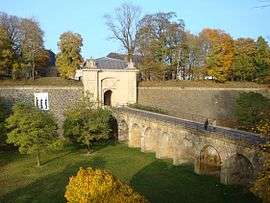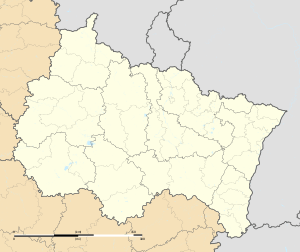Longwy
Longwy (French pronunciation: [lɔ̃wi]; Historical German: Langich, Luxembourgish: Longkech) is a commune in the Meurthe-et-Moselle department in northeastern France.
Longwy | |
|---|---|
 Porte de France | |
 Coat of arms | |
Location of Longwy 
| |
 Longwy  Longwy | |
| Coordinates: 49°31′12″N 5°45′38″E | |
| Country | France |
| Region | Grand Est |
| Department | Meurthe-et-Moselle |
| Arrondissement | Briey |
| Canton | Longwy |
| Intercommunality | Longwy |
| Government | |
| • Mayor (2008–2014) | Édouard Jacque (PR) |
| Area 1 | 5.34 km2 (2.06 sq mi) |
| Population (2017-01-01)[1] | 14,378 |
| • Density | 2,700/km2 (7,000/sq mi) |
| Time zone | UTC+01:00 (CET) |
| • Summer (DST) | UTC+02:00 (CEST) |
| INSEE/Postal code | 54323 /54400 |
| Elevation | 250–396 m (820–1,299 ft) (avg. 254 m or 833 ft) |
| Website | mairie-longwy.fr |
| 1 French Land Register data, which excludes lakes, ponds, glaciers > 1 km2 (0.386 sq mi or 247 acres) and river estuaries. | |
The inhabitants are known as Longoviciens.
Economy
Longwy has historically been an industrial center of the Lorraine iron mining district. The town is known for its artistic faience, produced there since 1798, and carried on today by the Société des faïenceries de Longwy et Senelle, often in cooperation with artists and ceramists. Overglaze enamel decoration, often in a manner similar to cloisonné, has been produced in Longwy ceramics since 1872,[2] initially under the direction of Amadeo de Carenza; these decors reached a peak in the Art Deco style, retailed by the Parisian department store Printemps.[3]
History

Longwy initially belonged to Lotharingia. After the division of that kingdom, the town became part of Upper Lorraine and ultimately the Duchy of Bar. Longwy was ceded to Wenceslaus I of Luxembourg in 1368, but was returned to Bar in 1378. The Duchy of Bar was then annexed into the Duchy of Lorraine in 1480.
From 1648 to 1660 Longwy was part of the Kingdom of France, returning to the Duchy of Lorraine afterwards. It was made part of France again in 1670, a situation which was finalized in the Treaties of Nijmegen in 1678. Vauban fortified the town during the reign of Louis XIV, having demolished the medieval Château de Longwy, of which one tower remains.
After the French defeat in the Franco-Prussian War of 1870–71, almost all of the Moselle department, along with Alsace and portions of the Meurthe and Vosges departments, was ceded to the German Empire by the Treaty of Frankfurt on the ground that the population in those areas spoke German dialects. Only one-fifth of Moselle, including Longwy, was spared annexation. Otto von Bismarck later bitterly regretted his decision when it was discovered that the region of Briey and Longwy was rich with iron ore, exploited by the Aciéries de Longwy among other members of the cartel Comptoir Métallurgique de Longwy.
After the Battle of the Ardennes in August 1914, Longwy was occupied by the Imperial German army until the 1918 Armistice.
People
- Count Claude Florimond de Mercy (1666–1734), Holy Roman Empire Field Marshal
- François Dominique Séraphin (1747–1800), French puppeteer
- Jean-Baptiste Fresez (1800–1867), Luxembourgish painter
- Paul Delisse (1817–1888), French trombonist
Miscellaneous
In 2008, the ville neuve ("New Town") was listed as a UNESCO World Heritage Site, as part of the "Fortifications of Vauban" group.
European route E411 passes through Longwy.
References
- "Populations légales 2017". INSEE. Retrieved 6 January 2020.
- Emaux de Longwy,
- Historique: émaux et faïences
External links

- Town council website (in French)